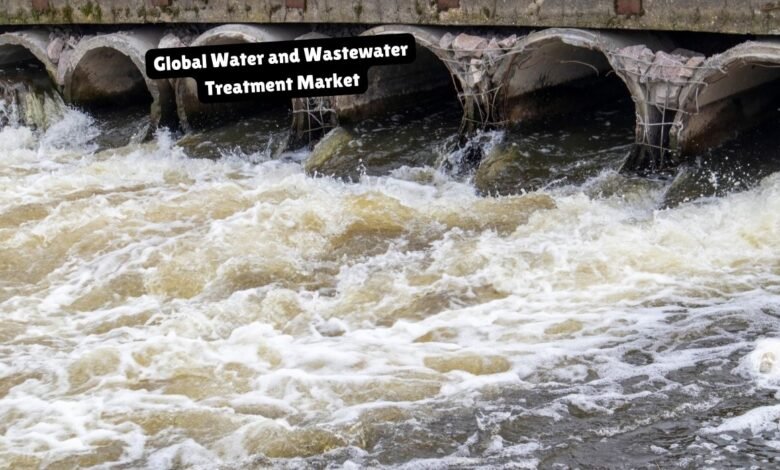Global Water and Wastewater Treatment Market
Explore insights into the global water and wastewater treatment market, highlighting trends

The global water and wastewater treatment market has been experiencing significant growth, driven by increasing urbanization, industrial activities, and a growing awareness of the importance of sustainable water management. As cities expand and populations rise, the demand for clean and safe water continues to escalate, placing immense pressure on existing water resources and treatment infrastructures. Consequently, the water treatment industry has become a critical component in ensuring access to potable water and maintaining environmental health.
Water treatment processes are essential in removing contaminants, pathogens, and pollutants from water, making it safe for human consumption and use. Additionally, wastewater treatment plays a vital role in mitigating the adverse effects of industrial and domestic wastewater discharge on the environment. By treating wastewater before it is released back into natural water bodies, these processes help preserve aquatic ecosystems and prevent waterborne diseases.
In recent years, the global market for water and wastewater treatment has shown a robust growth trajectory. Technological advancements, stringent regulatory frameworks, and increased investments in water infrastructure have been key drivers propelling this sector forward. According to market research, the sector is poised to surpass a valuation of $1 trillion by 2033. This impressive forecast underscores the escalating need for efficient water management solutions and the industry’s pivotal role in addressing global water challenges.
The journey to this projected milestone is marked by significant contributions from various segments within the market, including municipal, industrial, and residential sectors. Innovative treatment technologies, such as advanced filtration, desalination, and biological treatment methods, are being increasingly adopted to enhance the efficiency and effectiveness of water and wastewater treatment processes.
As the world grapples with issues such as water scarcity, pollution, and climate change, the importance of the water and wastewater treatment market cannot be overstated. This sector not only ensures the provision of safe water but also supports sustainable development and environmental conservation efforts globally.
Key Drivers of Market Growth
The global water and wastewater treatment market is poised for substantial growth, projected to surpass $1 trillion by 2033. Several key factors are driving this expansion, each playing a crucial role in shaping the industry’s trajectory. Understanding these drivers is essential for stakeholders to navigate the evolving market landscape effectively.
Increasing Population: The world’s population continues to grow, leading to heightened demand for clean water and efficient wastewater management solutions. As more people require access to safe drinking water and sanitation services, the pressure on existing water treatment infrastructure intensifies, necessitating significant investments in advanced treatment technologies.
Urbanization: Rapid urbanization is another major contributor to market growth. As more people migrate to urban areas, the need for robust water and wastewater treatment systems becomes more pronounced. Urban centers require large-scale infrastructure to manage the influx of residents and the corresponding increase in water consumption and wastewater generation.
Industrialization: The expansion of industrial activities worldwide has led to increased water usage and the generation of industrial wastewater. Industries such as manufacturing, pharmaceuticals, and food processing rely heavily on water, and the treatment of industrial wastewater is critical to prevent environmental contamination. This trend drives the demand for specialized treatment solutions capable of handling complex industrial effluents.
Stringent Environmental Regulations: Governments worldwide are implementing more stringent environmental regulations to protect natural water resources and ensure public health. Compliance with these regulations necessitates the adoption of advanced water and wastewater treatment technologies. Companies are increasingly investing in innovative solutions to meet regulatory requirements and avoid potential penalties.
These key drivers collectively underscore the urgent need for sustainable and efficient water and wastewater treatment solutions. As the market continues to evolve, stakeholders must stay informed about these trends to capitalize on emerging opportunities and address the growing challenges effectively.
Innovative Technologies in Water Treatment
The global water and wastewater treatment market is witnessing a transformative phase, driven by innovative technologies that are poised to redefine the industry. These advancements are crucial in addressing the growing demand for clean water and the need for sustainable solutions.
Filtration technologies have seen significant advancements. Traditional sand and gravel filters are being replaced by advanced membrane filtration systems, which offer higher efficiency and better contaminant removal. Membrane bioreactors (MBRs), for instance, combine biological treatment with membrane filtration, providing a compact and highly effective solution for wastewater treatment.
Desalination, a vital technology for regions with limited freshwater resources, has also seen remarkable progress. Conventional thermal desalination methods, such as multi-stage flash distillation, are now being supplemented or replaced by reverse osmosis (RO) systems. RO systems use semipermeable membranes to remove salt and other impurities from seawater, making it a more energy-efficient and cost-effective option.
Sustainable treatment methods are at the forefront of innovation. Techniques like Advanced Oxidation Processes (AOPs) and electrocoagulation are being developed to address emerging contaminants that traditional methods cannot effectively remove. Additionally, the adoption of renewable energy sources for powering treatment plants is becoming increasingly common, reducing the carbon footprint of these facilities.
Comparison of Traditional vs. Innovative Technologies
| Aspect | Traditional Technologies | Innovative Technologies |
|---|---|---|
| Filtration | Sand and Gravel Filters | Membrane Filtration Systems |
| Desalination | Thermal Desalination | Reverse Osmosis |
| Sustainability | Conventional Treatment | Advanced Oxidation Processes, Electrocoagulation |
| Energy Source | Fossil Fuels | Renewable Energy |
The integration of these innovative technologies is expected to propel the water and wastewater treatment market forward, making it more efficient, sustainable, and capable of meeting future demands. As the market continues to evolve, these advancements will play a critical role in ensuring the availability of clean water for all.
Regional Market Analysis
The global water and wastewater treatment market is segmented into several key regions, each contributing uniquely to the market’s expansion. North America, Europe, Asia-Pacific, and other regions such as Latin America and the Middle East & Africa play pivotal roles in driving the industry’s growth trajectory.
North America
North America represents one of the most mature markets for water and wastewater treatment. The presence of stringent regulations on water quality and wastewater discharge, coupled with substantial investments in infrastructure development, has propelled the market forward. The United States and Canada are the primary contributors in this region. The Clean Water Act in the U.S. and stringent Canadian guidelines have mandated the modernization of aging water infrastructure, presenting substantial growth opportunities.
Europe
In Europe, the market is driven by robust regulatory frameworks and a strong emphasis on sustainability. Key players in this region include Germany, the United Kingdom, and France. The European Union’s Water Framework Directive and Urban Wastewater Treatment Directive have been significant catalysts. Additionally, Europe’s commitment to addressing climate change and reducing pollutants in water bodies has led to increased investments in advanced water treatment technologies.
Asia-Pacific
Asia-Pacific is anticipated to be the fastest-growing region in the global water and wastewater treatment market. Rapid urbanization, industrialization, and population growth in countries like China, India, and Japan are primary drivers. China, with its stringent environmental policies and significant government funding, stands out as a leader. India’s ambitious initiatives such as the Clean Ganga Project and Smart Cities Mission are also contributing significantly to market growth. Japan’s advanced technology and its focus on sustainable practices further bolster the region’s market prospects.
Other Regions
Latin America and the Middle East & Africa are also emerging as important regions in the water and wastewater treatment market. Brazil and Mexico are key players in Latin America, driven by increasing urban population and industrial activities. In the Middle East & Africa, countries like Saudi Arabia and South Africa are investing heavily in desalination and water recycling projects to address water scarcity issues.
In essence, each region’s unique challenges and regulatory frameworks significantly influence the global water and wastewater treatment market, with North America, Europe, and Asia-Pacific leading the charge.
Major Market Players
The water and wastewater treatment market is characterized by the presence of several key players who dominate the industry through innovation, extensive market reach, and significant contributions to sustainability efforts. These companies drive the market forward with their technological advancements and strategic initiatives. Below is a detailed table listing the major market players, their market share, and notable achievements or contributions.
| Company | Market Share | Notable Achievements |
|---|---|---|
| Veolia Environnement | 15% | Leader in innovative water treatment solutions and sustainable water management practices. |
| SUEZ | 12% | Renowned for its advanced wastewater treatment technologies and circular economy initiatives. |
| Xylem Inc. | 10% | Focuses on smart water solutions and has made significant strides in water reuse and resource recovery. |
| Danaher Corporation | 8% | Known for its comprehensive portfolio of water quality and treatment solutions, including disinfection and filtration. |
| GE Water & Process Technologies | 7% | Pioneers in industrial water treatment and sustainable water resource management. |
Veolia Environnement tops the list with a substantial market share of 15%, recognized for its innovative water treatment solutions and commitment to sustainable water management. SUEZ follows closely with a 12% market share, lauded for its advanced wastewater treatment technologies and initiatives promoting the circular economy. Xylem Inc., holding 10% of the market, emphasizes smart water solutions and has been instrumental in advancing water reuse and resource recovery. Danaher Corporation and GE Water & Process Technologies, with 8% and 7% market shares respectively, are also key players, offering a broad range of water quality and treatment solutions. Their contributions underscore the importance of continuous advancements and the implementation of sustainable practices in the water and wastewater treatment market.
Challenges and Barriers
The global water and wastewater treatment market, projected to exceed $1 trillion by 2033, faces a myriad of challenges and barriers that could potentially impede its growth. These obstacles range from high costs and technological limitations to stringent regulatory requirements. A comprehensive understanding of these challenges is essential for stakeholders to navigate this complex landscape effectively.
One of the primary challenges in the water and wastewater treatment market is the high cost associated with the implementation and maintenance of advanced treatment technologies. These costs can be prohibitive for many municipalities and industries, particularly in developing regions where budget constraints are more pronounced. Furthermore, the initial capital investment required for setting up treatment plants can be significant, deterring potential investors.
Technological limitations also pose a substantial barrier. While there have been significant advancements in treatment technologies, issues such as energy efficiency, scalability, and the ability to handle diverse types of contaminants remain prevalent. Innovative solutions are continuously being developed, but the pace of technological evolution and adoption can be slow, hindering widespread implementation.
Regulatory hurdles add another layer of complexity to the market. Different countries and regions have varying standards and regulations concerning water and wastewater treatment, which can create inconsistencies and compliance challenges for companies operating on a global scale. Navigating this regulatory landscape requires substantial expertise and resources, further complicating market entry and expansion.
Pros and Cons of Current Market Conditions
To provide a clearer picture, the following table breaks down the pros and cons of the current market conditions in the global water and wastewater treatment sector:
| Pros | Cons |
|---|---|
| Increasing demand for clean water | High initial capital investment |
| Technological advancements | Energy efficiency issues |
| Regulatory support in developed regions | Complex regulatory landscape |
| Rising awareness of environmental sustainability | Maintenance and operational costs |
Understanding and addressing these challenges and barriers is crucial for leveraging the opportunities in the global water and wastewater treatment market. Stakeholders must adopt a strategic approach to navigate these impediments, ensuring sustainable growth and advancement in this critical sector.
Future Market Projections and Trends
The global water and wastewater treatment market is projected to experience significant growth, with forecasts indicating it will surpass $1 trillion by 2033. This growth is driven by several key factors, including technological advancements, regulatory pressures, and increasing awareness of environmental sustainability.
One of the most notable trends anticipated in the coming years is the adoption of advanced treatment technologies. Innovations such as membrane bioreactors, advanced oxidation processes, and nanotechnology are expected to become more prevalent, offering more efficient and effective solutions for water purification and wastewater management. These technologies not only improve the quality of treated water but also enhance the efficiency of treatment processes, thereby reducing operational costs.
Emerging markets, particularly in Asia-Pacific and Latin America, are also poised to play a crucial role in the market’s expansion. Rapid urbanization, industrialization, and population growth in these regions are expected to drive the demand for robust water and wastewater treatment infrastructure. Governments in these regions are increasingly investing in upgrading their water treatment facilities to meet the rising demand for clean water and to address environmental concerns.
Another significant trend is the increasing integration of digital technologies and smart systems in water and wastewater treatment processes. The use of Internet of Things (IoT) devices, artificial intelligence (AI), and data analytics is set to revolutionize the industry by enabling real-time monitoring, predictive maintenance, and optimized resource management. These advancements will not only improve the efficiency and reliability of treatment systems but also provide valuable insights for better decision-making.
Key Takeaways
- The global water and wastewater treatment market is expected to exceed $1 trillion by 2033.
- Advanced treatment technologies, such as membrane bioreactors and nanotechnology, are set to gain prominence.
- Emerging markets in Asia-Pacific and Latin America will significantly contribute to market growth.
- Digitalization and smart systems will enhance the efficiency and reliability of water and wastewater treatment processes.
Conclusion and Implications: Global Water and Wastewater Treatment
The global water and wastewater treatment market, set to exceed $1 trillion by 2033, underscores the critical importance of sustainable water management practices in an era marked by increasing environmental challenges. The projected market growth highlights the urgency for enhanced investment in water infrastructure, innovative treatment technologies, and robust regulatory frameworks to ensure the availability of clean water for future generations.
This anticipated market expansion signifies a transformative period for the global water industry. Policymakers are urged to prioritize legislative measures that incentivize the adoption of advanced water treatment solutions and support research and development initiatives. Such policies will not only facilitate market growth but also contribute to the achievement of global sustainability goals.
For businesses, the burgeoning market presents a plethora of opportunities to innovate and expand their service offerings. Companies involved in water and wastewater treatment can capitalize on the growing demand for efficient, cost-effective, and environmentally friendly solutions. By investing in cutting-edge technologies and fostering collaborations with stakeholders, businesses can play a pivotal role in driving the industry’s evolution.
Individuals also have a part to play in this global endeavor. Conscious water consumption, advocacy for sustainable practices, and support for policies that promote water conservation can collectively contribute to the broader goal of water sustainability. Each effort, no matter how small, can make a significant impact when combined with global initiatives.
- Young Employees Are Increasingly Struggling at Work, While Older Workers Fare Better
- Generative AI for Security: Harnessing Amazon Bedrock for Customer Impact
Impending milestone of a $1 trillion valuation for the water and wastewater treatment market reflects the critical need for concerted efforts across all sectors of society. By prioritizing sustainability, embracing innovation, and fostering collaboration, we can work towards a future where access to clean and safe water is guaranteed for all. This goal requires immediate and sustained action from policymakers, businesses, and individuals alike, ensuring a resilient and sustainable water future.



